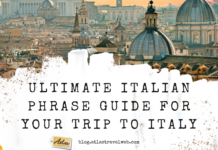Noted for its provincial hilltop towns and lush valleys steeped in medieval history, Tuscany is the premier wine-producing region of Italy and one of its most picturesque. Montalcino, situated in the heart of Tuscany not far from Siena and about 2 hours from Florence, produces one of the oldest and most prestigious wines in the region. We’ll share with you the wines of Montalcino Italy, and the history of this beautiful Tuscan town often missed by those traveling to Italy.
Montalcino takes its name from a type of oak tree that once grew there and dates back to the 9th century when Monks commenced construction of a church adjacent to an existing abbey. Montalcino experienced a population explosion in the 10th century and became a fortress in the 13th century to halt domination by Siena. At that time, Montalcino was noted for its tanneries and leather products. Wine production did not begin until the 14th century.
The grandeur of hearty olive groves, lush vineyards, sprawling oak and cypress trees and fragrant flowers greets you as you approach this storybook hamlet in the Orcia River Valley. Venturing into Piazza del Popolo, or town center, you come upon the Palazzo dei Priori, the city’s town hall. Incorporated into the palazzo is the enormous medieval clock tower looming high above the piazza. Spend some time perusing the ancient relics and artifacts in the churches of Sant’ Agostino, Sant’ Egidio and San Francesco. Be sure to visit the Museo del Vetro for a lesson on the history of glass-making. The museum, inside the lovely castle of Poggio alle Mura, boasts an intriguing collection of Egyptian, Roman, and Venetian glass treasures.
Within the walls high above the town center lies the fortress, or Rocca, which has remained mostly intact since the Middle Ages. Today, the fortress often serves as a venue for special events, including the famous Jazz & Wine Festival held annually in July, now in its 17th year.
 Not to be missed inside the fortress are the Chiesa di Sant’Agostino, (pictured to the left,) a church built in the 13th century in Romanesque style and the Musei Riuniti, a cluster of civic and religious museums that contain many artistic treasures made of wood and terra cotta. Finally, the Duomo, a cathedral built in the 14th century, has a neoclassical look today, thanks to extensive renovations in the early 19th century.
Not to be missed inside the fortress are the Chiesa di Sant’Agostino, (pictured to the left,) a church built in the 13th century in Romanesque style and the Musei Riuniti, a cluster of civic and religious museums that contain many artistic treasures made of wood and terra cotta. Finally, the Duomo, a cathedral built in the 14th century, has a neoclassical look today, thanks to extensive renovations in the early 19th century.
The fortress overlooks 8,000 acres of grapevines serving the working vineyards of Montalcino, well-known for its fine red wines by the 15th century. In 1888, Ferruccio Biondi Santi began using only the Sangiovese grape to produce the now-famous Brunello varietal. The wine is well-known worldwide as Brunello di Montalcino.
This wine gained a reputation as one of Italy’s finest by the end of World War II. Biondi Santi was still the only commercial producer of Brunello, with vintages only in 1888, 1891, 1925 and 1945. By the 1960s, there were at least 11 Brunello producers. Today there are almost 200 winemakers producing this high-quality red.
Brunello di Montalcino is a full-bodied, dry wine with vibrant garnet red color and an intense but refined bouquet, good tannins, solid structure, strong body and an ethereal aroma. Brunello wine must age for a minimum of four years, two of which must be in oak barrels. The wine must be bottled at least 4 months before commercial release. This contributes to its premium pricing.
The area produces two other varieties of Brunello. Brunello Montosoli is produced in a vineyard northeast of Montalcino, where soil composition and microclimate collaborate to yield an extremely complex yet elegant wine. Brunello Montosoli has a deep ruby red color, which turns a garnet red with age.

The other variety is Brunello di Montalcino Riserva. Brunello can only be designated as “Riserva” if it has aged for five years in the cellar. A limited number of bottles are produced only in the best years. Brunello Riserva is for truly passionate wine lovers and commands a high price. This garnet red wine has a broad, complex and ethereal aroma and great depth.
Rosso, another varietal from the Sangiovese grapevines, is refined in oak barrels for eight months and marketed after a minimum of one year after harvest. Brilliant ruby red, Rosso has a lasting bouquet of fresh fruit and wild berries and is well-balanced on the palate. As a younger wine, it is more within the price range of casual wine consumers.
A wine-tasting tour is a must when visiting Montalcino and should include Altesino Winery & Estate, Castello Banfi, Poggio Rubino, Fattoria di Barbi and Biondi Santi, the Brunello inventor.
The wines from the Sangiovese grapes pair well with red meats, duck, pheasant, squab and aged cheeses. Enjoy these local varietals with Tuscan favorites, like ‘bistecca fiorentina,” herb and cheese stuffed ravioli with shaved black truffles, or rosemary-roasted pig. Spring visitors will want to try the fried zucchini flowers, and summertime tourists should not pass up the “pappa col pomodoro, or bread soup, made with day-old saltless Tuscan bread, fresh tomatoes and basil, drizzled with extra virgin olive oil.
The adventurous may want to sample the cuisine of nearby Seggiano (southeast of Montalcino). Il Silene, considered by locals and visitors alike to be the best restaurant in the Montalcino area, serves “Scottiglia,” a gourmet “zuppa” of mixed meats, a typical Seggiano dish that never disappoints.
Typical streets in the Town of Montalcino, Italy










